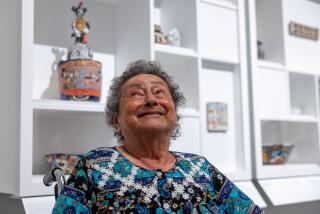‘Magú’ Luján dies at 70; influential Mexican American artist
- Share via
Gilbert “Magú” Luján — a painter, muralist and sculptor whose whimsical, slyly humorous art works, frequently evoking a rollicking, mythical view of Mexican American life, graced museum walls, the Hollywood and Vine subway station and other public places — died Sunday, according to a Facebook posting by his family. He was 70.
The Pomona resident had been battling cancer for several years, according to a number of friends and colleagues who confirmed that he died.
A pioneer of the Chicano art movement that took root in the social and cultural upheavals of the 1960s and ‘70s, Magú, as he was universally known, was among the first U.S. artists of Mexican descent to establish an international career.
He also was an enthusiastic facilitator of gatherings and exhibitions of Chicano artists and art collectives, most prominently the Chicano collective known as Los Four, and a catalytic figure in bringing their work to the wider art-viewing public, as well as to art scholars and critics.
“One only has to examine the barrio to see that the elements to choose from are as infinite as any culture allows,” Magú once remarked.
In an interview Monday, Chon Noriega, director of the UCLA Chicano Studies Research Center, described Magú as a “change agent” who drew inspiration not only from his deep knowledge of art history but from the various communities where he made his home in greater Los Angeles and the Fresno area.
Magú was also instrumental, Noriega said, in expanding the framework of Chicano art beyond mainly political concerns to aesthetic ones as well.
“He really defined a very unique role,” Noriega said. “Rather than seeing the art as merely a kind of instrument for social change,” Magú insisted that art “had to have integrity in order to have that impact.”
Drawing on indigenous Mesoamerican art and iconography, as well as the Chicano popular culture that surrounded him since his East L.A. youth, Magú populated his canvases and murals with Aztec-accessorized lowriders, plumed gods zipping by on serpentine skateboards, candy-striped pre-Columbian pyramids, humanlike animals and other flamboyantly colorful anthropomorphic creatures.
As a founding member of Los Four, which also included artists Carlos Almaraz, Beto de la Rocha and Frank Romero, Magú participated in a seminal four-man show at UC Irvine and subsequently in an expanded version of the show at the Los Angeles County Museum of Art in the early 1970s. Eventually, other artists, notably Judithe Hernandez, joined the group and exhibited their work under the Los Four moniker.
Born Oct. 16, 1940, in French Camp, Calif., near Stockton, Magú moved as a child with his family to East Los Angeles. He acquired his nickname, he later told interviewers, when friends noticed him squinting at artworks while inspecting them, like the nearsighted cartoon character Mr. Magoo.
After serving in the military, he attended Cal State Long Beach and earned a degree in ceramic sculpture in 1969.
As a student, Magú began organizing get-togethers of artists and other cultural and social activists that eventually evolved into regular encounters that he called Mental Menudos.
“He would gather people together to talk about social issues, but also to keep people motivated and highly optimistic and to keep doing their work despite the lack of support,” recalled L.A. visual and performance artist Harry Gamboa Jr., a member of another trailblazing Chicano collective, ASCO.
Between 1976 and 1980, Magú taught at the La Raza Studies Department at Fresno City College, where he also served as department chairman. Later he taught art at Cal Poly Pomona, while maintaining his personal studio, Magulandia, in downtown Pomona.
In addition to LACMA, the artist’s work has been exhibited at the Corcoran Gallery in Washington, D.C., the Brooklyn Museum, and the Houston Museum of Fine Arts.
In 1990, Magú was commissioned to design a series of movie-themed wall tiles and lowrider-shaped benches for the new Hollywood and Vine subway station. According to a 1999 story in the Los Angeles Times, Magú took to the assignment with his usual energy and equanimity.
“I was a Zen Buddhist for many years,” he said then, “and that teaches you to just breathe deeply while everything turns out the way it does.”
According to magulandia.com, the dA Center for the Arts will host a benefit, “Cruisin’ Magulandia,” next month in Pomona to promote the artist’s legacy.
Information about survivors was unavailable Monday.
More to Read
Start your day right
Sign up for Essential California for the L.A. Times biggest news, features and recommendations in your inbox six days a week.
You may occasionally receive promotional content from the Los Angeles Times.







